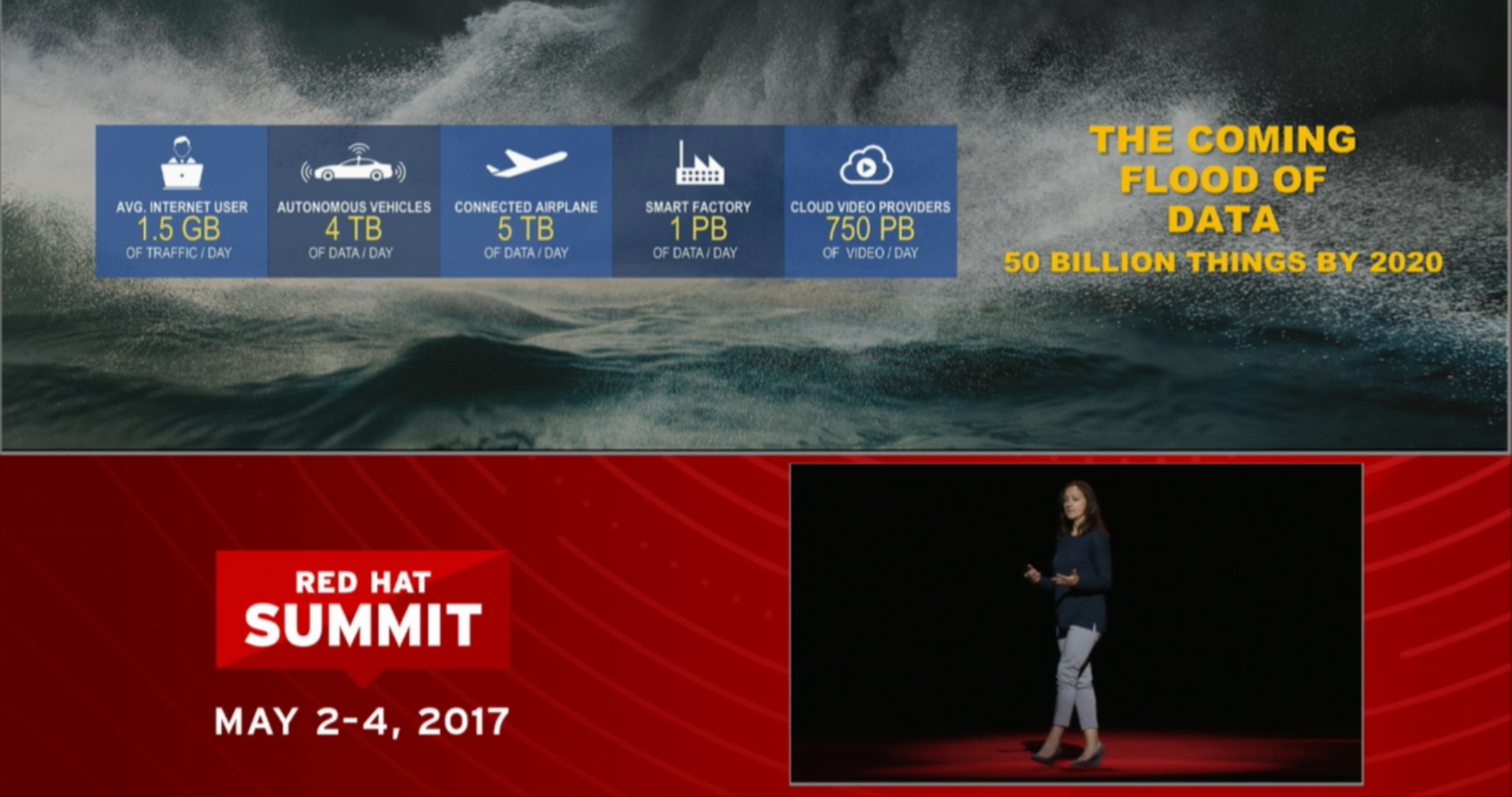 CLOUD
CLOUD
 CLOUD
CLOUD
 CLOUD
CLOUD
Day one of Red Hat Summit in Boston, Massachusetts, brought together major open-source contributors in a keynote address to discuss how open-source collaboration and the 5G network are combining to manifest a hyper-connected world.
“The call of action for all of us, all of you developers, is to take advantage of all of the capabilities 5G, artificial intelligence and data analytics are bringing into an environment where the network infrastructure looks really much more like a server than a purpose-built network appliance,” said Sandra Rivera, vice president and general manager of the network platforms group at Intel Corp.
Rivera started her talk with a nod to Red Hat Inc. and Intel for their open-source contributions. “Intel and Red Hat are the number one and number two providers or contributors to the Linux kernel, and we have been for over 10 years,” she told Summit attendees.
Intel is keeping a close eye on how open-source is aiding the development of the 5G network, which it already takes into account in researching and developing its own technologies. “5G fundamentally redefines how the entire infrastructure is architected,” she said.
The proliferation of connected devices requires the perfection of the 5G network to operate at peak and provide the instantaneous feedback experience intended, she added. “And really it is that connectivity of all of the things to the cloud through this network infrastructure that gives you computing capabilities throughout that entire spectrum of transaction between device and cloud,” Rivera stated.
To enable this connectivity, Intel is looking at memory technologies such as field-programmable gate array. “It allows you that programmability that you need as you have evolving standards, evolving algorithms and evolving use cases,” she explained.
Enhanced Mobile Broadband offers advanced memory for the augmented and virtual reality applications that run in autonomous vehicles. These self driving cars and all applications that use artificial intelligence require an advanced 5G network, Rivera said.
Expanding on the AI topic, Sam Ramji, vice president of product management at Google Inc., spoke during the keynote about how Google’s open-source machine learning library TensorFlow is benefiting from open source.
“This project is absolutely on fire,” he said, adding that the open-source contributions have dramatically fattened the libraries. “Open source is not about the code; it’s about the community that uses, participates, gives back, criticizes, documents and popularizes a project,” he said.
Container management platform Kubernetes also started at Google and gained tons of adoption and engagement after being released to the open-source community, Ramji told attendees.
Red Hat Vice President and Chief Technologist Chris Wright joined Ramji to discuss the evolution of Kubernetes, to which Red Hat has contributed.
“Another interesting space for the future and for Kubernetes is helping support what I would call workload specific optimizations,” Wright said. TensorFlow, for instance, could get a boost from working on Graphics Processing Unit compute systems, he said. “If you don’t have access to GPUs, you’re probably not getting the same performance that you’re looking for,” he added.
Red Hat and Google are two stellar examples of profitable entities that use open-source technology and also give freely to the open-source community.
This mining of open-source as a raw material was pointed up by Bryan Thompson, general manager of OpenStack Private Cloud at Rackspace Inc., which uses Red Hat’s OpenStack platform in its private cloud offering.
“We offer Red Hat OpenStack Platform delivered as a service with a 99.9 percent availability uptime in any data center,” he said.
Red Hat’s Distributed Continued Integration, which tests hardware compatibility, allows RackSpace to make the latest version of OpenStack available to customers within two weeks of release. “We’ve had a lot of interest from enterprises,” Thompson said.
Speaking of which, even enterprises and organizations typically reluctant to leave their data centers are warming to cloud — if the talk from Pat Healey, chief technology officer of infrastructure and shared technology services at Deutsche Bank, is an indication.
“We get our infrastructure from HP and IBM today; in the future, we want to drive toward the public cloud,” Healey revealed to attendees.
Watch the complete keynote video below, and be sure to check out more of SiliconANGLE’s and theCUBE’s independent editorial coverage of Red Hat Summit 2017. (* Disclosure: Red Hat Inc. sponsors some Red Hat Summit segments on SiliconANGLE Media’s theCUBE. Neither Red Hat nor other sponsors have editorial control over content on theCUBE or SiliconANGLE.)
Support our mission to keep content open and free by engaging with theCUBE community. Join theCUBE’s Alumni Trust Network, where technology leaders connect, share intelligence and create opportunities.
Founded by tech visionaries John Furrier and Dave Vellante, SiliconANGLE Media has built a dynamic ecosystem of industry-leading digital media brands that reach 15+ million elite tech professionals. Our new proprietary theCUBE AI Video Cloud is breaking ground in audience interaction, leveraging theCUBEai.com neural network to help technology companies make data-driven decisions and stay at the forefront of industry conversations.